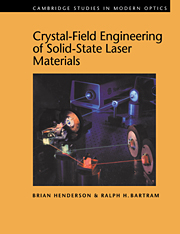Book contents
- Frontmatter
- Contents
- Preface
- 1 An introduction to lasers
- 2 Symmetry considerations
- 3 Optical crystals: their structures, colours and growth
- 4 Energy levels of ions in crystals
- 5 Spectra of ions in crystals
- 6 Radiationless transitions
- 7 Energy transfer and excited state absorption
- 8 Covalency
- 9 Engineering the crystal field
- 10 The crystal field engineered
- References
- Index
3 - Optical crystals: their structures, colours and growth
Published online by Cambridge University Press: 24 September 2009
- Frontmatter
- Contents
- Preface
- 1 An introduction to lasers
- 2 Symmetry considerations
- 3 Optical crystals: their structures, colours and growth
- 4 Energy levels of ions in crystals
- 5 Spectra of ions in crystals
- 6 Radiationless transitions
- 7 Energy transfer and excited state absorption
- 8 Covalency
- 9 Engineering the crystal field
- 10 The crystal field engineered
- References
- Index
Summary
Natural minerals and gemstones
There are several thousand naturally occurring minerals, inorganic compounds of fixed chemical composition and regular sub-microscopic structure. Not more than 100 or so of these are recognized as gemstones although the number may vary as fashions change and new sources are found. Gemstones are hard and durable to withstand regular use without damage. But most particularly, they are beautiful, in their colour and lustre, especially when cut, faceted or polished for personal adornment. Beauty notwithstanding, the most important quality of a gemstone is scarcity. To be rare is to be greatly valued.
Minerals that are the basis of gems are found in rocks which form over aeons in time: where they are found reflects the process of continuous formation. There are three main classes of gem-bearing rocks. Sedimentary rocks are formed by the accumulation of eroded rock fragments, which settle over time, are compressed and again harden into rock. They are set down in layers which eventually emerge from below the earth's surface. Gypsum is a typical sedimentary rock with important variations in alabaster and selenite. Opal and tourmaline occur as veins in such sedimentary rocks as shale. Igneous rocks solidify from molten rock deep beneath the earth's surface, sometimes escaping in lava flows from erupting volcanoes. The slower the rate at which the molten rocks cool, the larger are the gems that grow within them. In consequence, gems grow at high temperature, under huge hydrostatic pressures.
- Type
- Chapter
- Information
- Crystal-Field Engineering of Solid-State Laser Materials , pp. 61 - 92Publisher: Cambridge University PressPrint publication year: 2000



